Linlithgow Palace is located in West Lothian about 15 miles (24 km) west of Edinburgh, off the M9. The name “Linlithgow” comes from the Old British and means “lake in the damp hollow”…

Linlithgow Castle and St Michael’s Church © 2007 Scotiana
Even if you have planned to go directly to Stirling Castle and Wallace Monument don’t miss Linlithgow Palace. This magnificent ruin, for the old palace lost its roof long ago, is well-worth the visit as St Michael’s church which stands just nearby with its amazing 58ft high crown made of anodised aluminium. The surrounding park is quite pleasant too. You can walk around the loch, look at the palace from a distance, watch the birds flying over the loch and the colourful little boats sailing on its peaceful waters.
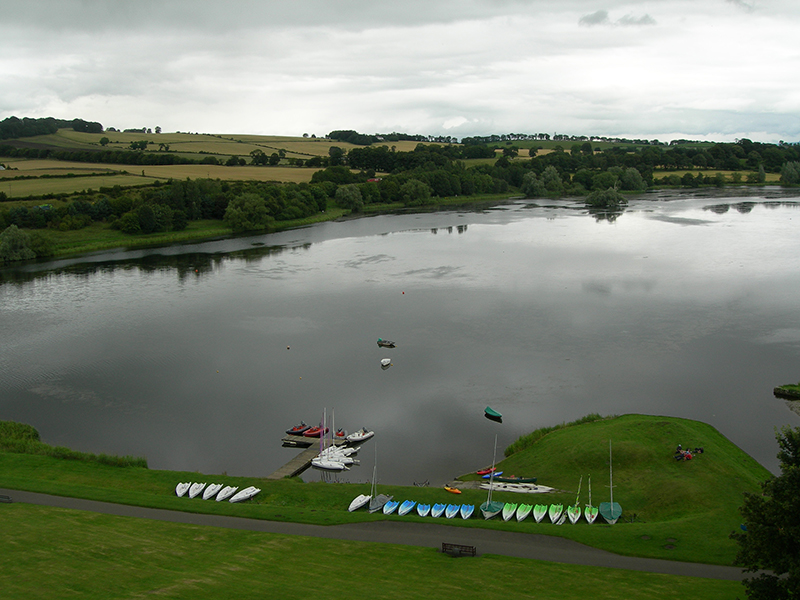
Linlithgow loch © 2003 Scotiana
We visited Linlithgow Palace in September 2003 and returned there in July 2007 hoping to be able to see James V’s fountain, a wonderful architectural gem standing in the middle of the courtyard. James V had offered it as a wedding gift to Mary of Guise in 1538. The fountain was undergoing restoration works when we first visited the place.
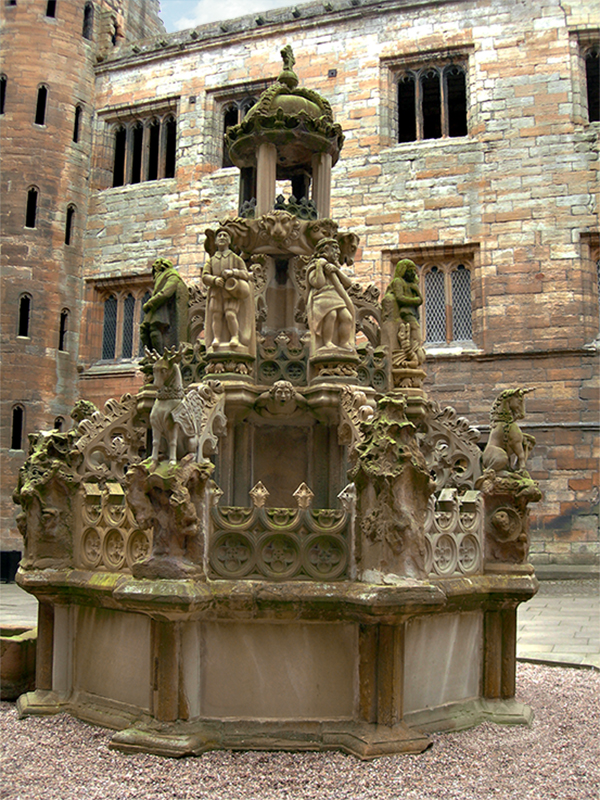
Linlithgow Palace the fountain in the courtyard © 2007 Scotiana
This magnificent sandstone fountain, a 3-tiered structure decorated with emblematic carvings, is the oldest surviving of its kind in Britain. It is said that at times of great festivities, such as the King’s wedding or Bonnie Prince Charlie’s visit in 1745, it did not flow with water but with wine 😉 It could have flowed with blood when the castle was occupied by the troops of the Duke of Cumberland in 1746, a man of sinister reputation nicknamed “The Butcher”…
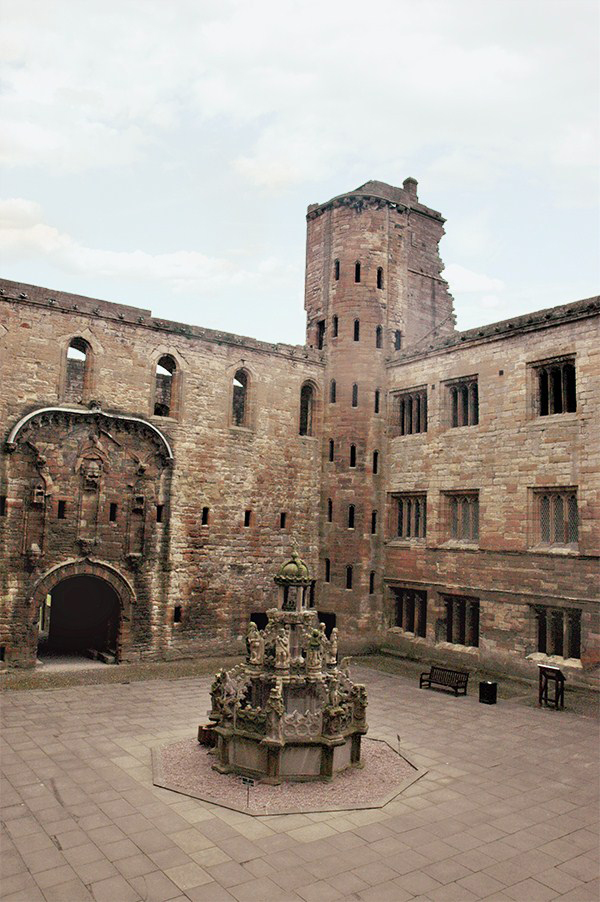
Linlithgow Palace the fountain in the courtyard © 2007 Scotiana
But let us retrace our steps in order to begin at the beginning 😉
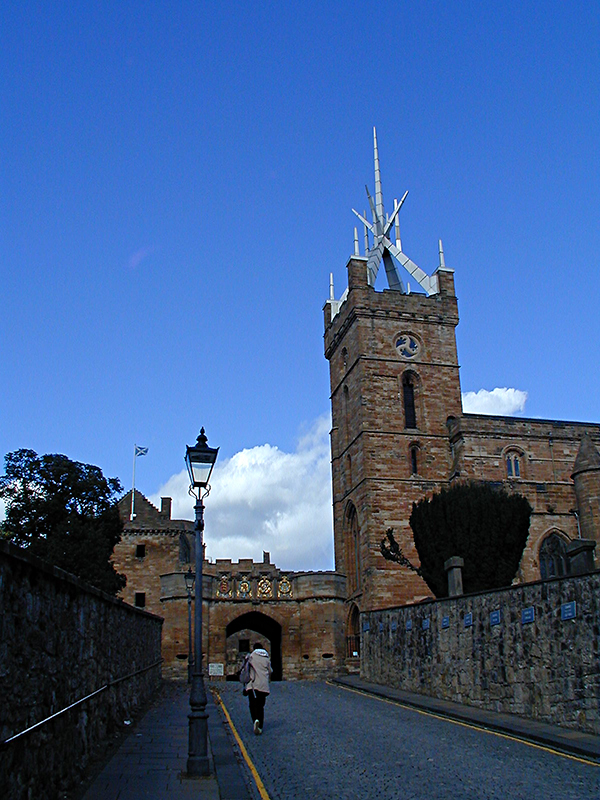
St Michael’s Church & Palace Outer Gate Kirkgate Street © 2003 Scotiana
After following Kirkgate Street…
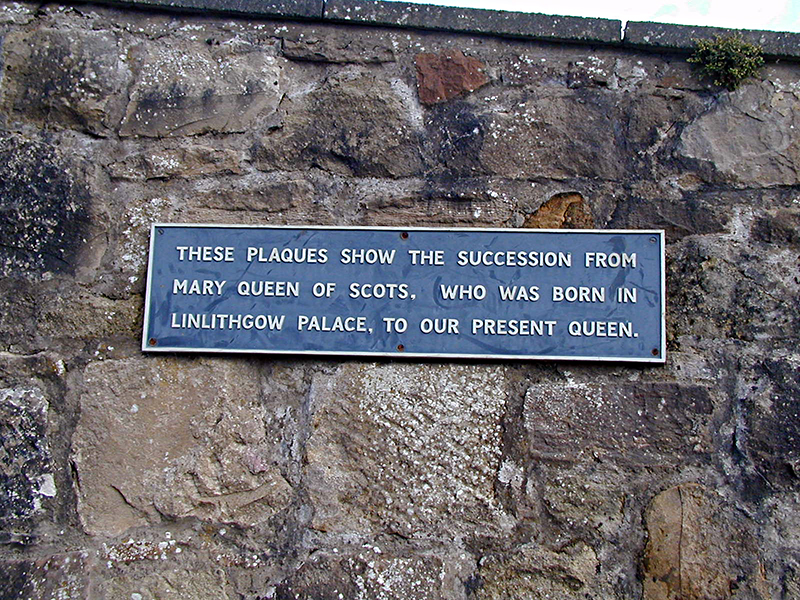
Linlithgow Kirgate Street Scottish Kings & Queens plaque © 2007 Scotiana
… desperately trying to memorize the list of Scottish Kings & Queens as their names appear on the wall…
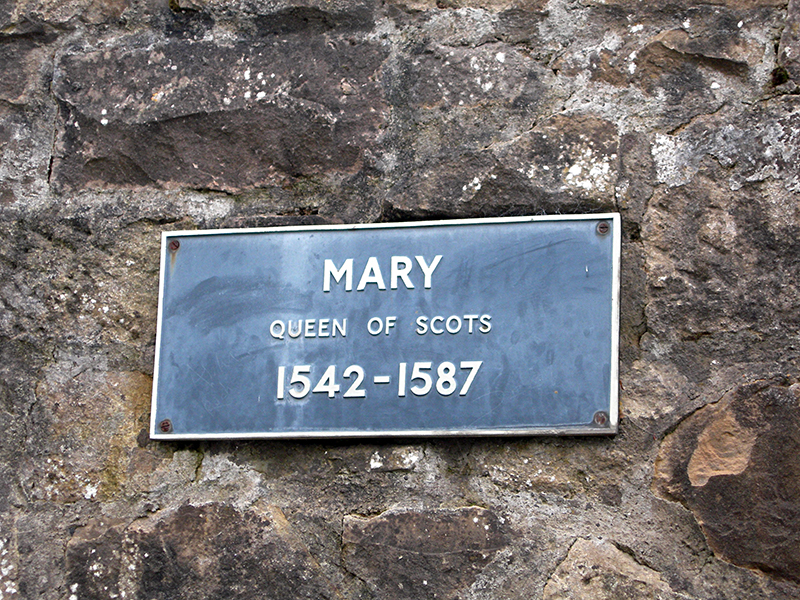
Linlithgow Kirgate Street Mary Queen of Scots plaque © 2003 Scotiana
… we arrive at a magnificent entrance, decorated with colourful emblems…
The Entrance
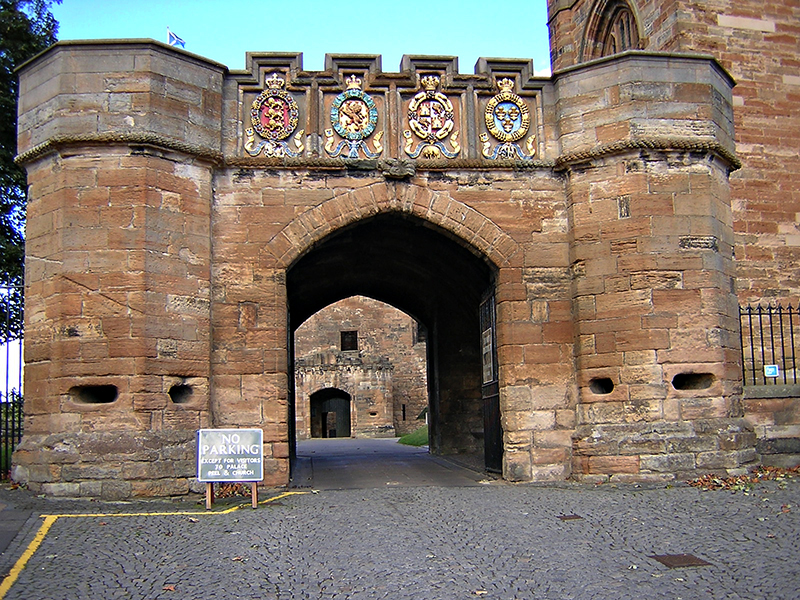
Linlithgow Palace Outer Gate © 2003 Scotiana
This is the outer gate built about 1535 for James V. This entrance replaced the old one built by James I and which was situated on the East range of the Palace.
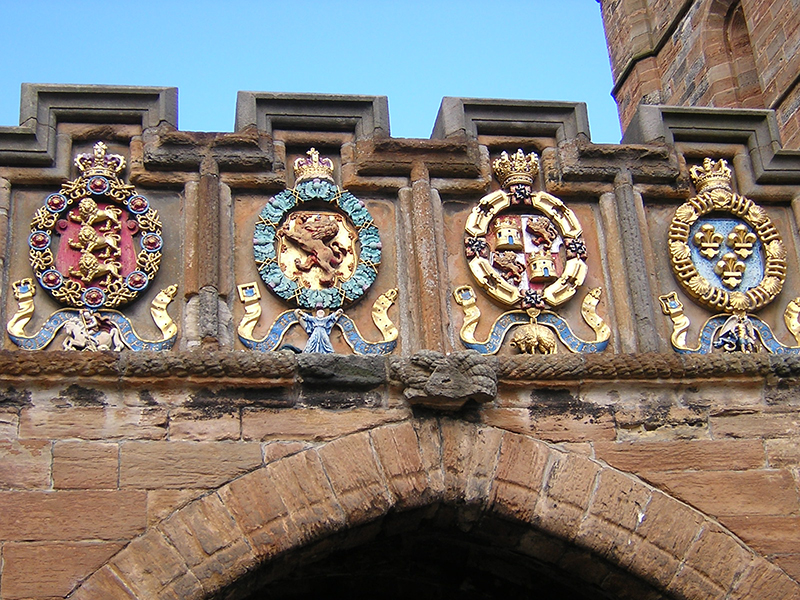
Linlithgow Palace Outer Gate the King’s Four Orders of Knighthood © 2003 Scotiana
The four repainted emblems one can see above the archway of the Outer Gate and represent the King’s four Orders of Knighthood: the Garter, The Thistle, St Michael, the Golden Fleece.
James V was elected Companion of the Order of the Garter by Henry VIII on 20th January 1535. He received the Order of St. Michael from Francis I, King of France in 1535 and the Order of the Golden Fleece from Emperor Charles V in 1534.
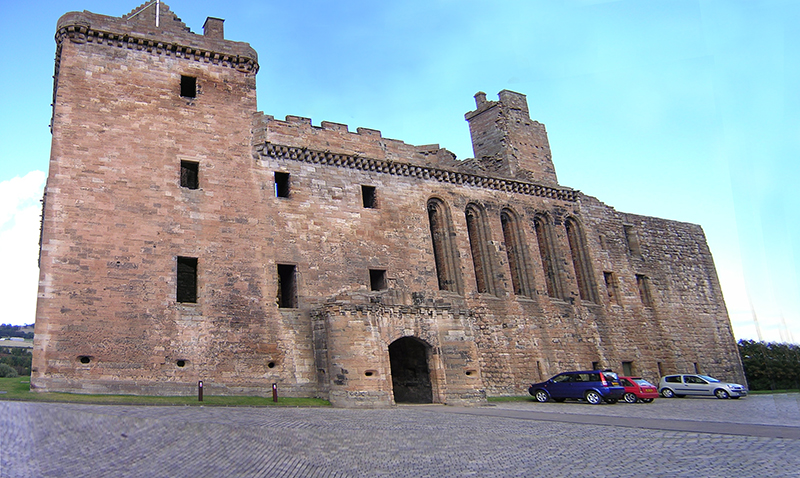
Linlithgow Palace South Range © 2003 Scotiana
Once we have passed the Outer Gate and St Michael’s Church, we follow the cobbled street which leads to the impressive south range of the palace and to the main entrance.

The high arched windows are those of the Chapel.
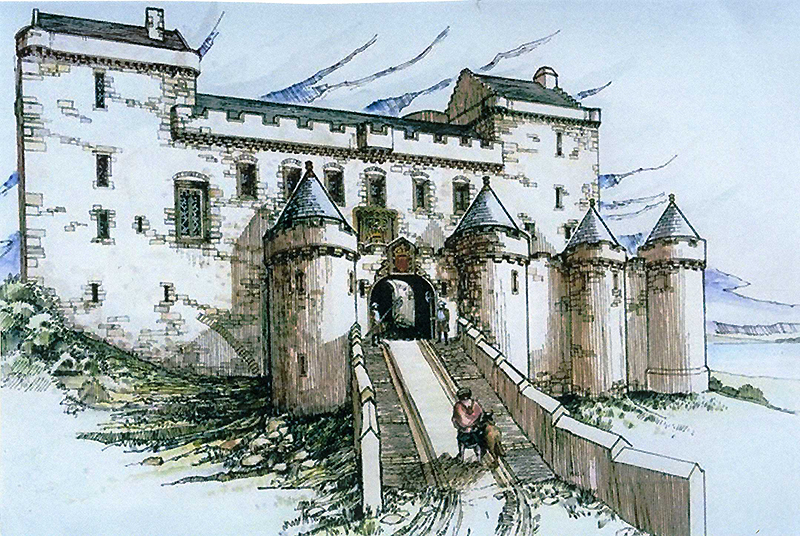
Linlithgow Palace East Range Historic Scotland panel illustration
The above illustration shows the East range of the Palace built by King James I. It contained the original entrance. The barbican was added by James IV but there is not much left of the four towers today.
We are now ready to enter the Palace…
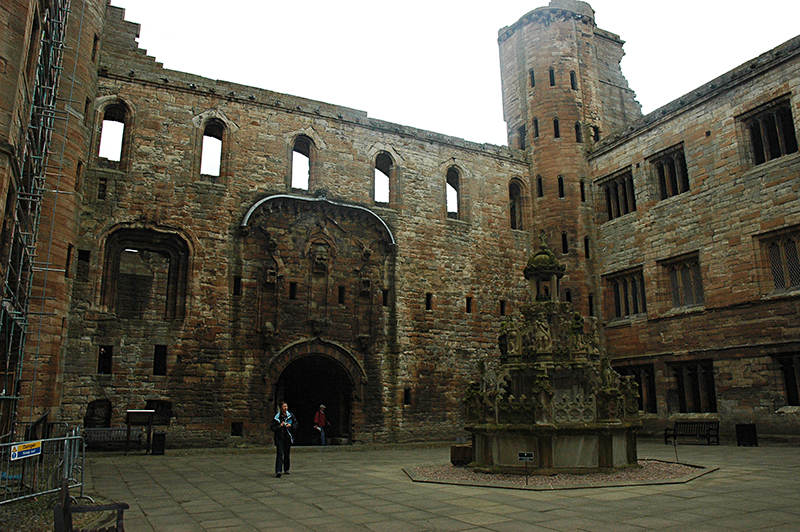
Linlithgow Palace East-South Range south east tower © 2007 Scotiana
Linlithgow Palace was designed as a quadrangle with a central courtyard and square towers in each corner. The videos at the end of my post show aerial views of the palace, which is quite useful to understand its plan.
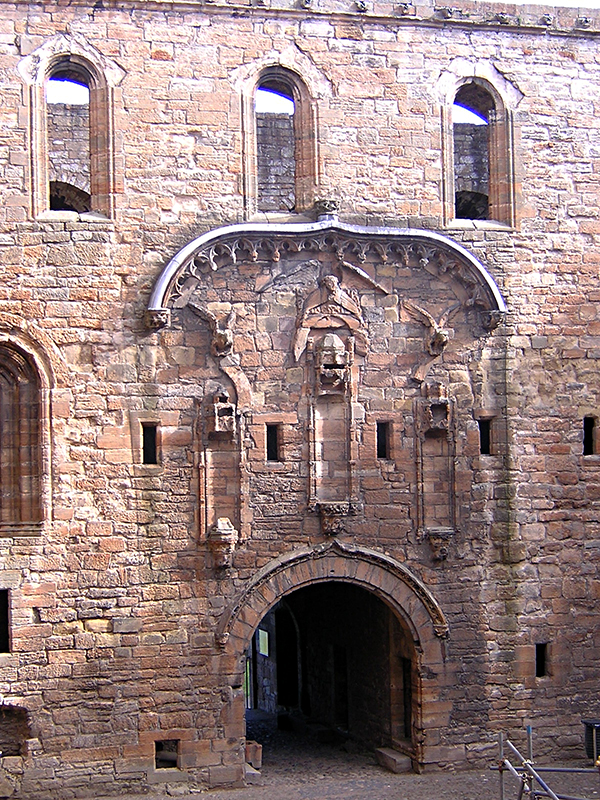
Linlithgow Palace East range gateway © 2003 Scotiana
Given of what is left of the beautifully decorated east entrance, it must have been magnificent at the time of James I when it was built.
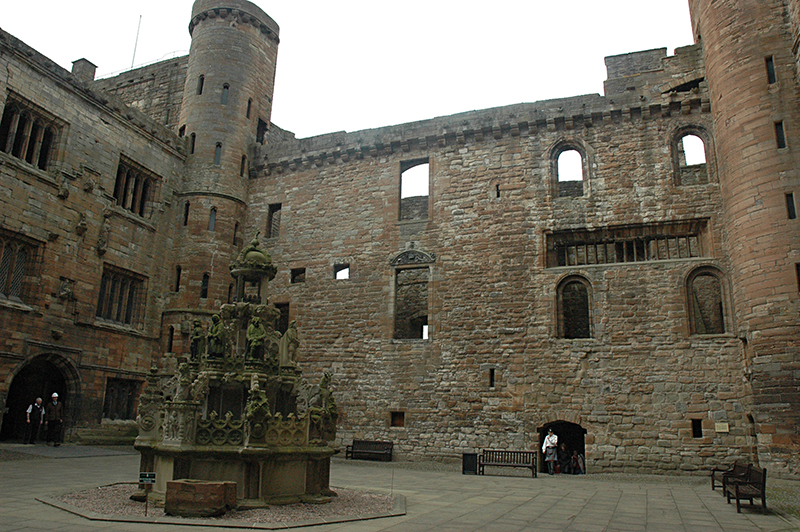
Linlithgow Palace West Range & Fountain © 2007 Scotiana
When it is not crowded it is very pleasant to sit in the courtyard, enjoying the place and letting one’s imagination wander up and down the old walls steeped in history.
The main historical landmarks of the place
The story of a royal residence in Linlithgow goes back to the night of time, dating back to the 1100s and even before though at the beginning it was neither a “castle” nor a “palace” but only a “manor house” used by the early Scottish kings. David I (1124-1153), who founded the burgh of Linlithgow, is often quoted as one of the first Scottish kings to have been associated with the place.
David I’s immediate successors seem to have been occasional residents of the royal house but didn’t leave many traces. As Rev. John Ferguson writes at the end of the first chapter of Linlithgow Palace “such are the mists which conceal the house from our view, that it is difficult to say whether it was built of wood or stone – was a castle or only a hunting-lodge”.
In 1301, at a time of political turmoil in Scotland when there was big competition for the Scottish Crown, Edward I of England, who had invaded Scotland in support of John Balliol’s claim to the throne, decided to use Linlithgow House, a strategical place between Edinburgh and Stirling, as a military base, building a fortification known as “The Peel”. The English stayed there 13 years. Nothing remains of what was probably a wooden and earth structure for, in 1313, Robert the Bruce (1306-1329) destroyed Edward’s “castle”, using a “Trojan Horse” strategy. After this short episode as a defensive “castle”, Linlithgow manor house was rebuilt by King David II (1329-1371).
In 1424 a big fire destroyed the town, the manor house and part of the church. James I (1407-1437), returning to Scotland after 18 years of captivity in England, decided to build a new royal residence on the site of the old one and also to rebuild St Michael’s Church which had served as a storeroom during Edward’s military occupation. King James I built the East Range containing the main entrance and also began the construction of the North and South ranges. The magnificent Great Hall dates back to his time though it has been modified since.
The Palace was used by the successive Stuart kings, each adding his own touch to the edifice. So it evolved over the centuries from a mere manor house to a magnificent palace which became a favourite residence of the Stuarts.
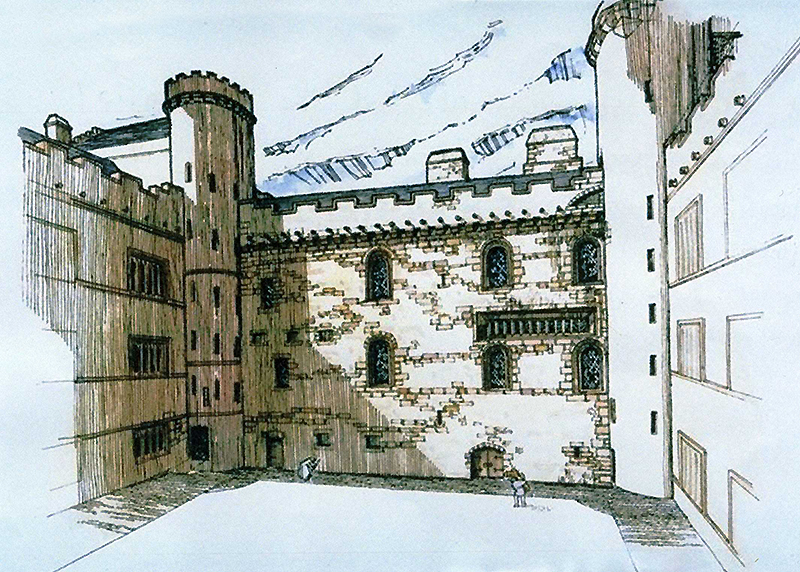
Linlithgow Palace West Range Historic Scotland panel illustration
James III (1460-1488) and James IV (1488-1513) were particularly fond of the palace to which they added major contributions. James IV is the one who built the west range and added the barbican outside. He also rebuilt earlier parts of the building, including the Great Hall. He would be killed in 1513 at the age of 40 at the battle of Flodden. It is said that his wife, Margaret Tudor, had been watching for his return from a place known today as ‘Queen Margaret’s Bower’ which is situated at the top of the north-west tower. Another story tells that the King had ignored the warning, delivered to him by a blue-robed ghost in St Michael’s, that predicted he would be killed if he went to battle against the English.
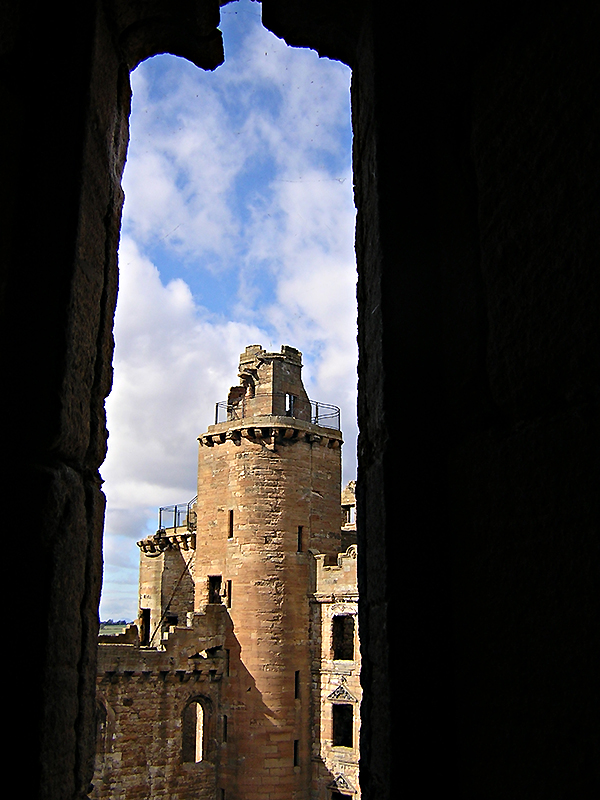
Linlithgow Palace Margaret’s Bower © 2003 Scotiana
James V was born at Linlithgow Palace on 10 April 1512. He completed the structure closing the old entrance and replacing it by the gatehouse we use today to enter the place and which is situated in the south range of the Palace.
Mary Queen of Scots was born at Linlithgow Palace on 8 December 1542 and she was only six days old when her father James V died at Falkland Palace, in Fife, not far from Linlithgow. The baby queen remained there no more than seven months. An agreement had been reached for her marriage to Edward, Prince of Wales in July 1543, but her mother, Mary of Guise, fearing that her daughter might be abducted moved her to Stirling Castle. Mary was preoccupied with other concerns than building castles. When her son succeeded her to the Scottish throne (at the age of one) Linlithgow was in a state of disrepair so that on 6 September 1607 the north range collapsed.
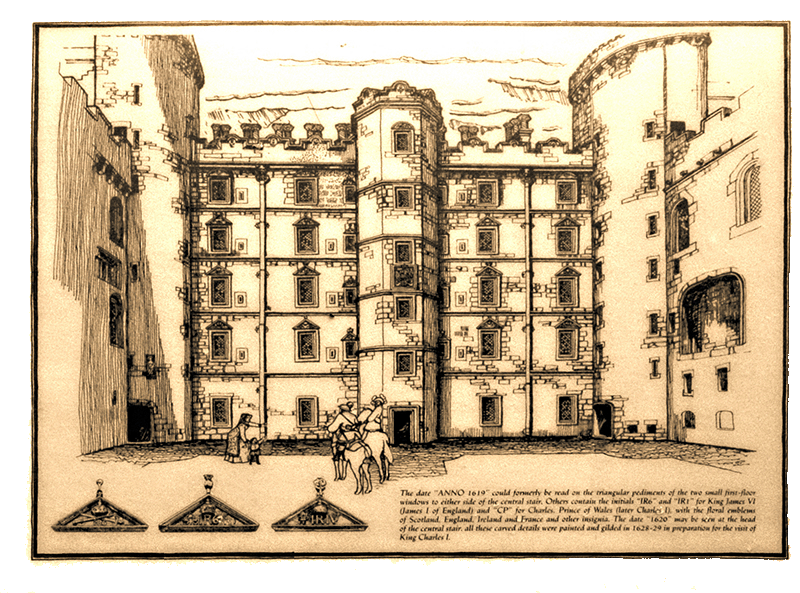
Linlithgow Palace North Range Historic Scotland panel illustration
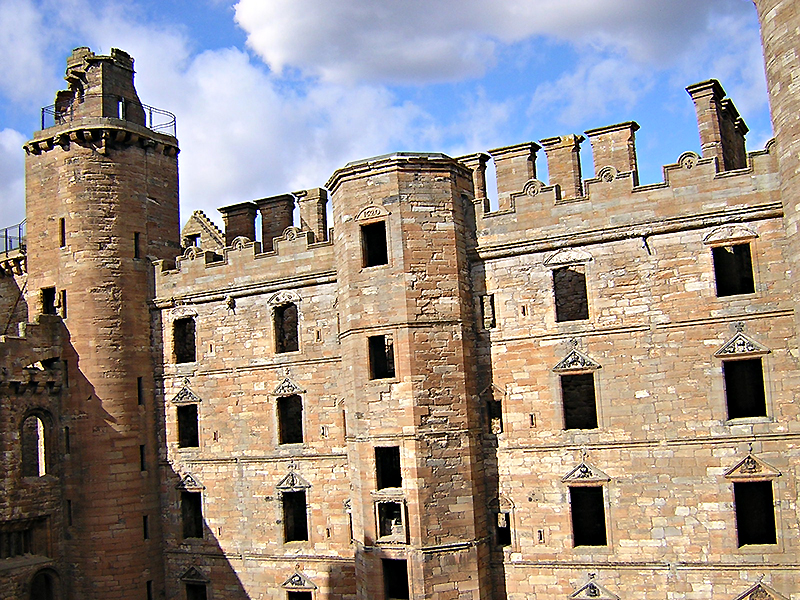
Linlithgow Palace North Range © 2003 Scotiana
Once ‘The Union of the Crowns’ had been signed between England and Scotland, in 1603, things were never the same. James VI/I moved to London leaving the palace in charge of a keeper which did not improved things. The palace continued to deteriorate. After the north range collapsed, James VI rebuilt it in the years 1618-20 but it never recovered its former grandeur.
The Palace was last used by a monarch in 1633 when Charles I stayed there.
Cromwell’s troops stayed there in 1650 and Bonnie Prince Charlie paid a short visit in 1745.
When the English troops which had occupied the palace in 1746 departed they left the palace ablaze which destroyed the roof and not only the roof. It was never repaired since.
The Palace is now in the care of Historic Environment Scotland. (HES)
THE INTERIOR OF LINLITHGOW PALACE
There are many rooms inside the palace and many of them can be visited.
We begin with the Chapel situated in the South range. Not many people are praying there but maybe are we surrounded by invisible presences… who knows 😉
The Great Hall which dates back to James I, though it was modified later, is still quite impressive but one need to travel back in time in order to fill it with people and things for the vast room is rather dark and empty today. Once again the HES panels are very useful, not to say indispensable, to best appreciate such a place.
It is an immense room with its 100 feet (30 m) long and 30 feet (9 m) wide and massive fireplace. Imagine the cheerful atmosphere of the place when big festivities were organized there, when the ceiling was still covered by a beamed roof such as the one you can find at Edinburgh or Stirling castles, when the walls were lined with luxurious tapestries and the hall filled with fine furniture. Can you hear the music ? There is a minstrel gallery running the whole length of the hall. Indeed, there was music in the Great Hall when we entered it in 2007 for a charming and very talented young piper was playing in front of the fireplace…
We sat on a stone bench and listen to him with much pleasure… his very moving music filled the room..
Many thanks to this young Scottish artist. It’s very hard to play the pipe…
Here is the Court Kitchen with again a massive fireplace…
The Royal Apartments… the King’s one on the first floor and the Queen’s above…
Note the beautiful tiled floor in the King’s bedchamber…
Here’s the level of the Queen’s apartment and “Margaret’s Bower”up the turret…
Wandering about the empty corridors… alone, or not…;-)
There are many corridors, it can be difficult to find one’s way…
What can be there, up this turnpike stair… let’s climb it…
Wow ! We can get a beautiful panoramic view of the area from the roof…
… but it’s not for those who are afraid of height, like me 😉
INSPIRATION
Such a place cannot be but inspiring and it did inspire generations of poets and artists, and contemporary people too.
“Of all the palaces so fair
Built for the royal dwelling
In Scotland, far beyond compare,
Linlithgow is excelling”
(Walter Scott – Marmion)
The romantic atmosphere of Linlithgow Palace is particularly well reflected in old engravings …
(Illustration from The Castles, Palaces, and Prisons of Mary of Scotland by Charles Mackie esq.)
The spectacle of an ancient palace, which at one time enshrined the royal honours of Scotland, where Princes feasted and heroes fought, resounding alternately with the clang of arms and the dulcet notes of peace, now surrendered to ruin and desolation, cannot fail to inspire feelings of melancholy and regret in the bosom of the lover of departed glories of his country.
The palace of Linlithgow is venerable for its antiquity, and must be forever hallowed by the mournful associations connected with its time-honoured ruins. No more do those princely halls contain the beauty and chivalry of Scotland, nor those battlements the formidable array of warlike hosts. The owl nightly hoots its dirge from the broken towers, and the note of the wild bird, exchanged for the music of the harp, screams its harsh requiem over departed greatness.
(Charles Mackie – The Castles, Palaces, and Prisons of Mary of Scotland -1850)
Linlithgow Palace attracts many people of all age today, all the more when historical events are organized by Historic Environment Scotland. Donald Cameron seems to be a fan of the place 😉
“In my heart of hearts I’ve always longed to step into a time machine, dial up an epoch, an era, and whisk myself back to a moment beyond memory, to a place where I might have a privileged front row seat as history unfolds.”
(Donald Cameron in the article “The King & I” published in Scots – The Journal of the Scots Heritage Society – Number 45 -August 2009)
This event organized at Linlithgow Palace by Historic Environment Scotland (HES) and described by Donald Cameron was meant to illustrate a momentous historical event which took place there in 1503: the wedding of King James IV and Margaret Tudor, the 14-year-old daughter of England’s King Henry VII.
James IV was very fond of Linlithgow Palace, as his son James V would be after him. Unfortunately James IV was killed at the battle of Flodden in 1513 and it is said that his wife, Margaret Tudor, had been watching for his return from the tower which is now known as ‘Queen Margaret’s Bower”.
My favourite book of reference about Scottish castles is Martin Coventry’s The Castles of Scotland. The last edition is a big book, not the kind to put in your luggage when you go to Scotland 😉 But you can take his Wee Guide to The Haunted Castles of Scotland published by Goblinshead.
“Martin was born in 1963 in Edinburgh, and from an early age had a passion for castles, battles and dragons, not least being greatly influenced by The Lord of the Rings and then by Robert E Howard’s stories about Conan.
Sadly growing up in the grey streets of the capital offered few opportunities for an aspiring adventurer, except Dungeons and Dragons (…)
At Slains Castle, one cold but beautiful day, was conceived a work on all the many castles, towers and fortified houses of Scotland in one handy volume, and so came along The Castles of Scotland and the publishing powerhouse that is Goblinshead.”
https://www.thecastlesofscotland.co.uk/the-author/
A very interesting old book, specifically dedicated to Linlithgow Palace is Rev. John Ferguson’s Linlithgow Palace – Its History and Traditions. It was published in 1910. Not only did this old book appealed to me with its beautiful cover and illustrations but I also felt that nobody could be better placed to write about Linlithgow Palace than one of the ministers of St Michael Parish Church.
(Linlithgow Palace Rev. Ferguson published in 1910 by Oliver & Boyd)
Linlithgow Palace
Its History and Traditions
WITH PEEPS FROM ITS WINDOWS AT THE BURGH AND SURROUNDING DISTRICT
by the
Rev. John Ferguson, D.D., F.S.A. (Scot.)
MINISTER OF LINLITHGOW
Five years ago I published a History of St Michael’s Church, which was favourably received by the Press and the Public. In collecting material for that work, it was scarcely possible to avoid collecting material for a history of the palace ; for the two buildings are not only adjacent, but their histories are interwoven and to a large extent inseparable.
As you can see on the above picture, the blue cover of Rev. John Ferguson is ornated with a lovely gilded engraving, illustrating one of the two coat of arms of Linlithgow which represents a black bitch chained to an oak tree standing on a mound in Linlithgow Loch. There is an engraving of it inside the book.
(The Black bitch of Linlithgow – Illustration from Linlithgow Palace by Rev. Ferguson 1910)
Linlithgow coat of arms is based on local tales.
The tree represents the former Royal Forest and the black bitch may be connected with the chase; it may also recall one of the possible meanings of Linlithgow, “the lake of the grey dog”.
Last but not least, if I was lucky to live in Scotland, I would certainly not miss the event organized at Linlithgow Palace by HES in next october 😉
Frightening Times at Linlithgow Palace
Visitors are invited to go back in time to the Linlithgow Palace of the 1850s this month with Historic Environment Scotland’s popular Fright Night event. Costumed performers will delve into the depths of the palace’s past to uncover sinister stories, bringing the unique historic site to life for those who are brave of heart.
With Halloween approaching, Linlithgow Palace is offering visitors the unique opportunity to see the historic site after dark. By day the high towers of the elaborate pleasure palace look out over lush greenery and a loch brimming with wildfowl – but things look a little different after dark.
The Victorian Era was a time of rapid scientific progress in Britain, and produced a wave of paranormal investigators, mystics and spiritualists interested in uncovering the secrets of things that went bump in the night. This Fright Night, visitors can follow Victorian Professor Michael and his sidekick, Night Watchman Gibby McPherson, as they enter the palace under cover of dark to investigate rumours of ghostly goings-on.
Hear spooky stories of witches and rat catchers, and meet some of the less pleasant characters from Scotland’s past.
Laura Gray, Assistant Events Manager for Historic Environment Scotland, which manages the palace, said: “Those looking for a scare this Halloween won’t do much better than Fright Night at Linlithgow Palace! The event gives people a unique opportunity to explore the darker side of Linlithgow Palace. Our costumed performers are great at building a strange and spine-tingling atmosphere, perfect for any brave souls wanting to do something a bit different this Halloween.”
https://www.historicenvironment.scot/about-us/news/frightening-times-at-linlithgow-palace/
That’s the end of the visit! I hope you enjoyed it 😉
À bientôt !
Mairiuna

























Thank you so much for these lovely photos and the exciting videos.
Linlithgow is one of my favourite places back home and I re-visited it this summer.
The Caledonian Society of France, of which I have the honour of being President,
made a substantial donation to the erection of the statue of Mary Queen of Scots that stands outside the palace. It is the only one of the Queen in Scotland, I understand, which is all the more surprising when one considers her important place in Scotia’s history.
Dear George,
We were very happy to hear from you again on Scotiana and we thank you very much for your kind and interesting comments about our last articles featuring Linlithgow Palace and the Kelpies. I’m very sorry to have taken so long to reply to your messages but I always find it difficult to devote as much time as I would like to our blog. But as we say in France “Mieux vaut tard que jamais !”
Old castles and abbeys rank high on the long list of our favourite Scottish subjects and we always try to visit and re-visit as many of them as we can when we travel in Scotland. Indeed, my next article in Scotiana will be about Falkland Palace. We’ve already planned to go back to Linlithgow on our next trip to Scotland because we never took time to linger outside the palace, to stroll around the loch nor to make an in-depth visit of St Michael’s Church. The picturesque little town of Linlithgow seems to be worth of visiting too. It’s always the same problem with us: too much to do in too short a time ;-). We’ll certainly also have a look at the new statue of Mary Queen of Scots which now stands in front of the Palace. It had been unveiled only a little time before our last visit to Scotland, in 2015, but we knew nothing about it then. I’ve mentioned this statue in my post about Alex Nye’s book For My Sins
https://www.scotiana.com/1586-from-her-prison-cell-mary-queen-of-scots-remembers/
We immediately fell in love with Andy Scott’s “Kelpies” near Falkirk. We would like to see these impressive sculptures by night, a much more comforting sight than to fall on one of those mythical water horses suddenly emerging from the dark waters of a loch. I remember our boat trip to Loch Coruisk with the Bella Jane, on a gloomy day. This loch which is lying at the foot of the Black Cuillin, in the Isle of Skye, is reputed to be the home of one of these malefic creatures… the place is beautiful but I won’t spend the night there…
I will try to find a list of Andy Scott’s statues which we can see in Scotland. I think there is a special Trail dedicated to the artist work. We are eager to see the bronze baby elephant sculpture which will be installed in a carpet of forget-me-nots, in Edinburgh’s Princes Street Gardens, as a memorial to the victims of “the Mortonhall baby ashs scandal”. A very moving idea !
We’ve learned that “The Caledonian Society of France”, of which you are the President, was founded in 1922 for Scots living in France. We would be very grateful if you could tell us more about it.
Looking forward to reading you, we wish you a very happy autumn time in Scotland or France.
Avec toutes nos amitiés.
Mairiuna and the whole team of Scotiana.